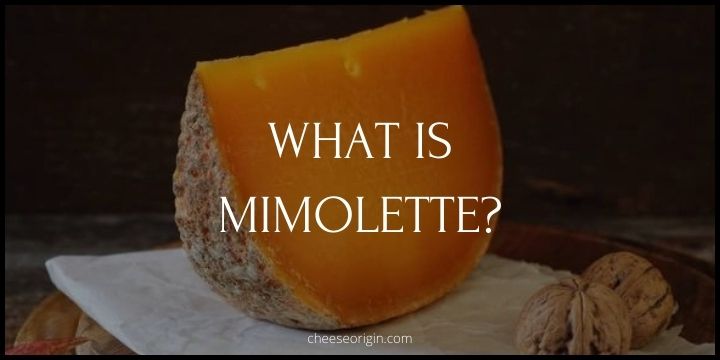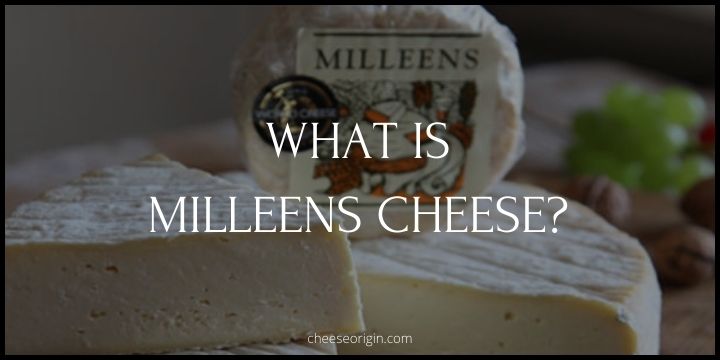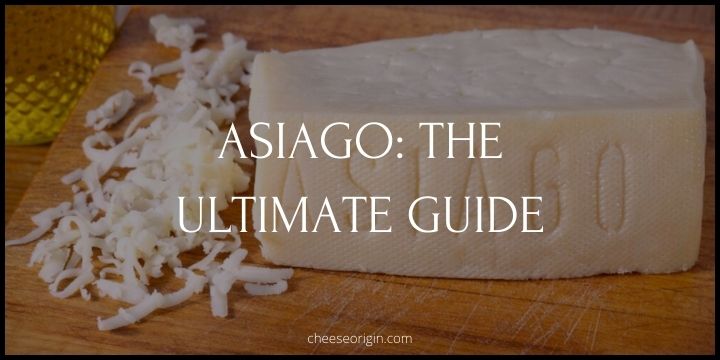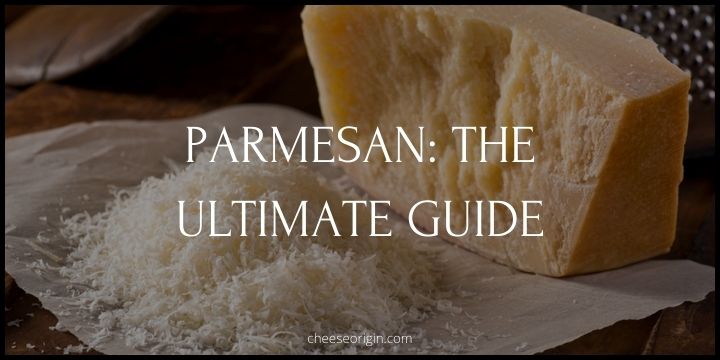What is Cantal Cheese? The Crown Jewel of French Cuisine

Today, we’re diving into the world of Cantal cheese – a true crown jewel of French cuisine. This isn’t just any cheese; it’s a testament to time, a story of a region, and a celebration of flavor that has captivated palates for over two millennia.
Born in the volcanic soils of Auvergne’s high-altitude pastures, Cantal cheese is a gastronomic treasure with a history as rich as its taste. So, fasten your seatbelts, or rather, prepare your taste buds, as we explore the fascinating world of Cantal cheese, a timeless masterpiece that continues to charm cheese connoisseurs and foodies alike.
Quick Facts About Cantal Cheese
| Fact Category | Details |
|---|---|
| Origin | Cantal cheese originates from the Cantal region in the Auvergne-Rhône-Alpes area of France |
| Cheese Type | It’s a semi-hard cheese made from raw or pasteurized cow’s milk |
| Ageing Process | The cheese is typically aged for at least one month, but some varieties are aged for up to six months or more |
| Flavor Profile | Cantal cheese has a mild, milky flavor when young that becomes sharper and more robust with age. It also has notes of grass and hay |
| Texture | The texture of Cantal cheese ranges from firm and smooth in younger cheeses to crumbly in older ones |
| Pairings | Cantal pairs well with full-bodied red wines, fresh fruits, and crusty bread |
| Nutrition | A 1-ounce serving of Cantal cheese contains approximately 120 calories, 10 grams of fat, and 7 grams of protein |
| Recognition | Cantal cheese has been granted AOC (Appellation d’Origine Contrôlée) status, which recognizes its unique regional characteristics |
What is Cantal Cheese?
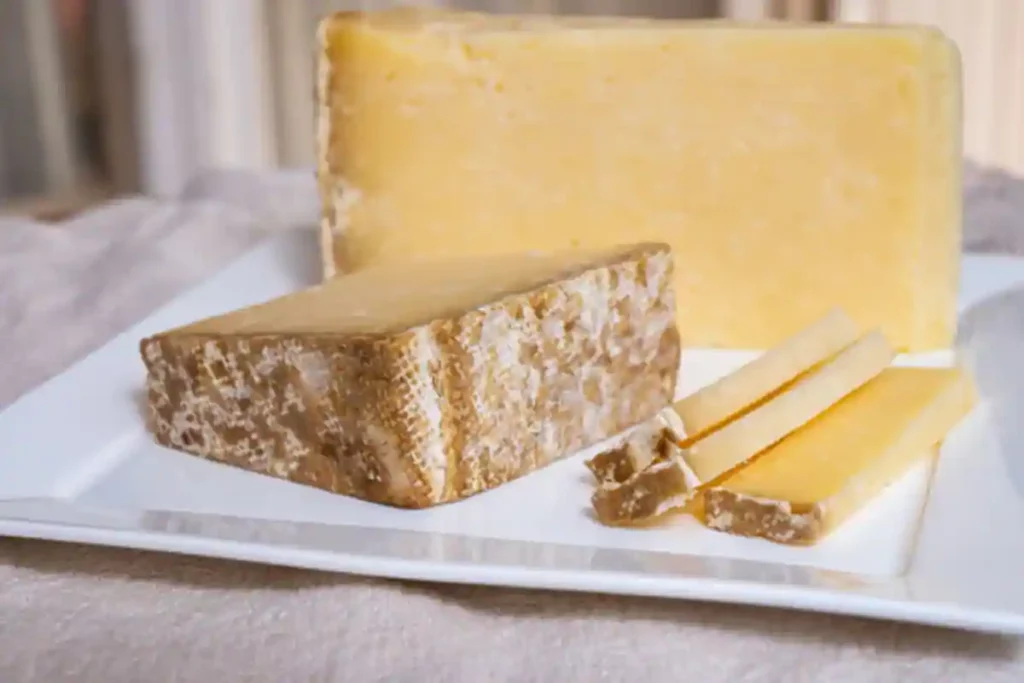
Cantal cheese, often known as the “crown jewel of French cuisine,” is a type of semi-hard cheese that originates from the Cantal region in the Auvergne-Rhône-Alpes area of France. This cheese has been deeply interwoven with French gastronomy and history, serving as a testament to the country’s profound cheese-making heritage.
One of the most intriguing aspects of Cantal cheese is its versatility. Made from raw or pasteurized cow’s milk, it can be enjoyed at various stages of aging. When young, Cantal cheese has a mild, milky flavor, making it a delightful addition to salads or a simple snack on its own. As it ages, the flavor becomes sharper and more robust, with subtle notes of grass and hay emerging. This complexity of flavor makes aged Cantal an excellent choice for grating over dishes or pairing with wine.
The texture of this cheese also varies with age. Young Cantal is smooth and firm, while older versions tend to be more crumbly, adding a unique texture to culinary creations. This transformative quality adds to Cantal’s appeal, making it a versatile ingredient in French cooking.
When it comes to pairings, Cantal truly shines. Its rich, complex flavors complement full-bodied red wines, fresh fruits, and crusty bread, making it a must-have on any cheese platter. It’s not just a delight for the taste buds; each bite of Cantal cheese is a journey into the heart of French gastronomy and tradition.
In recognition of its unique regional characteristics, Cantal cheese has been granted AOC (Appellation d’Origine Contrôlée) status. This certification ensures that every wheel of Cantal cheese you enjoy is made following strict standards, preserving the centuries-old traditions of the Cantal region.
What Does Cantal Cheese Taste Like?
Cantal cheese offers a distinct flavor profile that evolves as it ages. When it’s young, Cantal cheese presents a mild, buttery, and slightly tangy taste, similar to a mild cheddar or Monterey Jack. It has a milky sweetness that can be quite delightful.
As it ages, the flavor of Cantal cheese becomes more complex and robust. The mild sweetness gives way to sharper, more savory flavors with subtle notes of grass and hay, reminiscent of the pastures where the milk-producing cows graze. Some people also describe the taste as slightly nutty or earthy.
Aged Cantal can sometimes have small white crystals scattered throughout, which are a result of the cheese’s maturation and contribute to a slight crunch and an intensified flavor. This complexity makes aged Cantal a great choice for savoring on its own or pairing with a full-bodied wine.
In terms of texture, younger Cantal is smooth and creamy, while older Cantal tends to be drier and more crumbly. Regardless of its age, Cantal cheese offers a satisfying mouthfeel that complements its rich flavor.
It’s important to note that the flavor can vary slightly depending on whether the Cantal is made from raw or pasteurized milk, with raw milk versions generally offering a deeper, more nuanced flavor profile.
Cantal Cheese Tasting Notes

Young Cantal Cheese:
- Flavor: Mild, buttery, and slightly tangy, similar to a mild cheddar or Monterey Jack. It has a milky sweetness.
- Texture: Smooth and creamy, with a firmness that holds up well in cooking.
- Aroma: Fresh and slightly grassy, reflecting the pastures where the cows graze.
- Pairings: Light-bodied wines, fresh fruits, and crusty bread.
Aged Cantal Cheese:
- Flavor: More complex and robust, with sharper, savory flavors. Subtle notes of grass, hay, and sometimes a slight nuttiness.
- Texture: Drier and more crumbly than its younger counterpart. May have small white crystals that contribute to a slight crunch.
- Aroma: More pronounced and earthy, reflecting the longer aging process.
- Pairings: Full-bodied red wines, dried fruits, and hearty slices of bread.
Raw Milk Cantal Cheese:
- Flavor: Deeper and more nuanced flavor profile, with a balance of sweet, salty, and savory notes.
- Texture: Depends on the age of the cheese but generally has a more pronounced texture.
- Aroma: Richer and more complex, with hints of the natural environment where the milk-producing cows graze.
- Pairings: Robust red wines, honey, and artisanal breads.
What is Cantal Cheese Used for?
- Cheese Platters: Cantal, with its rich flavor and firm texture, makes an excellent addition to any cheese platter. It pairs well with fresh fruits like apples and grapes, as well as dried fruits and nuts.
- Cooking: Young Cantal can be used in cooking, where it melts beautifully. It’s perfect in gratins, fondue, quiches, or melted over potatoes. Aged Cantal can be grated over pasta, salads, or soups for a sharp, savory flavor boost.
- Sandwiches: Cantal cheese can be sliced and used in sandwiches. Its mild yet distinct flavor enhances the taste of cold cuts and veggies.
- Baking: You can use Cantal cheese in baking too. It can be incorporated into breads and pastries to add a cheesy twist to these baked goods.
- Pairing with Wine: Cantal cheese pairs wonderfully with wine. Aged Cantal goes well with full-bodied red wines, while younger Cantal can be paired with lighter white wines.
- Snacking: Cantal can be enjoyed on its own as a snack. The complex flavors of this cheese make it a satisfying treat at any time of the day.
What is the Difference Between Cheddar and Cantal Cheese?
| Aspect | Cheddar | Cantal |
|---|---|---|
| Origin | Cheddar, England | Cantal, France |
| Milk Used | Typically made from pasteurized cow’s milk | Can be made from raw or pasteurized cow’s milk |
| Texture | Smooth, dense, and firm | Ranges from semi-firm to hard, depending on age |
| Flavor | Nutty and sharp, especially when aged | Mild, buttery, and slightly tangy when young, but becomes more robust and savory with age |
| Aging Process | Usually aged between 9 to 24 months | Can be sold as young as 30 days (Cantal Jeune) or aged up to several months (Cantal Vieux) |
| Uses | Versatile – used in sandwiches, cheese platters, cooking, and baking | Also versatile – used in French cuisine, cheese platters, cooking, and baking |
| Production Process | Known for the “cheddaring” process where the curds are cut and stacked | The curds are pressed repeatedly to remove whey |
>> Click here to read our in-depth guide on Cheddar
Is Cantal a Healthy Cheese?
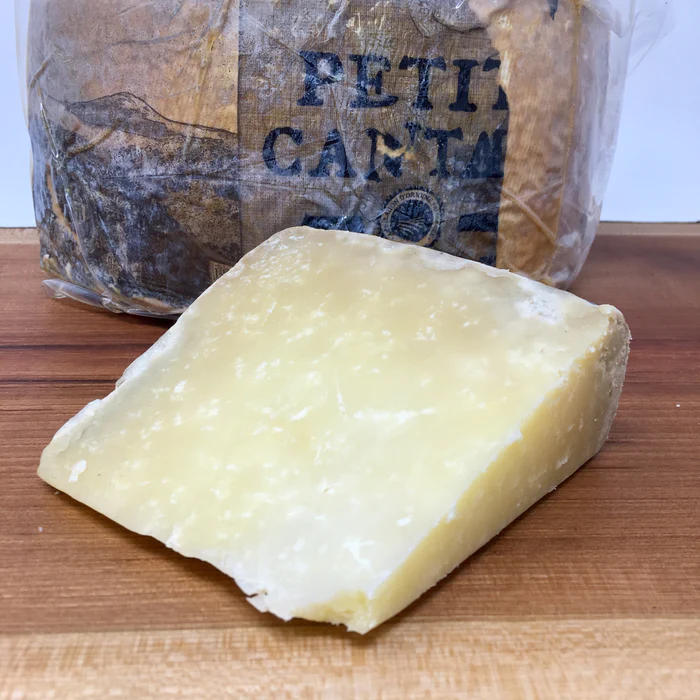
Health Benefits:
- Protein Content: With around 24.69 grams of protein per 100 grams, Cantal cheese is high in protein. Protein is a crucial macronutrient needed for tissue repair, energy provision, and immune function.
- Calcium Source: Like most cheeses, Cantal is a good source of calcium which is essential for bone health.
3 Things to Lookout For:
- Caloric Content: An ounce (about 28.35 grams) of Cantal cheese contains approximately 100 calories. This should be taken into account when considering daily caloric intake.
- Fat and Sodium: Cantal cheese contains fat, including saturated fat, and sodium. While these are necessary in moderation, excessive intake can lead to health issues such as heart disease and high blood pressure.
- Cholesterol: Cantal cheese also contains cholesterol. While the body needs some cholesterol to function properly, too much can increase the risk of heart disease.
While Cantal cheese has nutritional benefits, it should be eaten in moderation as part of a balanced diet.
As always, if you have specific dietary concerns or health conditions, it’s best to consult with a healthcare professional or a registered dietitian.
Cantal Cheese Nutrition Facts
| Nutrient | Amount per 1 oz (28 g) |
|---|---|
| Calories | 100 calories |
| Protein | 24.69 g |
| Fat | Approximately 67 g |
| Saturated Fat | 19.9 g |
| Carbohydrates | 0.8 g |
| Sugars | 0.8 g |
| Sodium | 2300 mg |
| Cholesterol | 300 mg |
| Calcium | Good source |
10 Best Cantal Cheese Substitutes
| Substitute | Reason |
|---|---|
| Cheddar | It has a similar texture to Cantal and a robust flavor that can stand in well for the French cheese. |
| Gruyère | Gruyère is a Swiss cheese with a slightly sweet, nutty flavor that is somewhat similar to Cantal. |
| Colby | This American cheese is mild and creamy, making it a good substitute for younger Cantal cheeses. |
| Monterey Jack | Another American cheese, Monterey Jack has a mild flavor and melts well, making it a good choice for cooking. |
| Emmental | This Swiss cheese is known for its distinctive holes and sweet, fruity flavor. It’s a good choice if you want a cheese that’s a bit sweeter than Cantal. |
| Comté | Comté is a French cheese that’s often compared to Gruyère. It has a complex flavor that can range from creamy and fruity to nutty and smoky. |
| Parmesan | If you’re looking for a cheese with a strong, savory flavor to replace aged Cantal, Parmesan could be a good option. |
| Provolone | This Italian cheese has a smooth texture and mild flavor that can work as a substitute for younger Cantal cheeses. |
| Mozzarella | While it’s milder in flavor than Cantal, mozzarella melts beautifully, making it a good choice for dishes that require melted cheese. |
| Manchego | This Spanish cheese has a crumbly texture and nutty flavor that can stand in for aged Cantal. |
Where to Buy Cantal Cheese?
- Fromages.com
- Whole Foods Market
- Cheesyplace.com
- Orrman’s Cheese Shop
- DeLaurenti Shop
- iGourmet
- Instacart
- Capella Cheese
- Calvert Woodley Wines & Spirits
Note: availability might vary based on your location, and it’s always a good idea to check the website or contact the retailer to confirm.
What Pairs Well with Cantal Cheese?

Food that goes well with Cantal Cheese:
| Food Category | Foods |
|---|---|
| Bread/Crackers | Baguette, Sourdough, Whole Grain Crackers, Rye Bread |
| Fruits | Apples, Pears, Grapes, Figs |
| Meats | Prosciutto, Salami, Smoked Turkey |
| Nuts | Almonds, Walnuts, Pecans |
| Condiments/Spreads | Honey, Fig Jam, Olive Tapenade |
| Vegetables | Roasted Red Peppers, Marinated Artichokes, Olives |
| Desserts | Dark Chocolate, Almond Biscotti, Fruit Tarts |
Also read: 11 Best Crackers that Pair Well with Cheese
Beverage that goes well with Cantal Cheese:
| Beverage Category | Beverages |
|---|---|
| Wine | Chardonnay, Sauvignon Blanc, Pinot Noir, Beaujolais |
| Beer | Pale Ales, Brown Ales, Belgian Tripels |
| Whisky | Scotch, Irish Whiskey, Bourbon |
| Non-Alcoholic | Sparkling Water, Apple Cider, Grape Juice |
Also read: Best Wine and Cheese Pairings: The Ultimate Guide
The History and Origin of Cantal Cheese

Cantal cheese is a culinary gem with a rich history dating back to the times of the Gauls, making it one of the oldest cheeses in France. The cheese is named after the Cantal mountain range, known for its volcanic soil and high-altitude sunny pastures, located in the heart of Auvergne, a region in central France.
The Gallic ancestors, more than two thousand years ago, first produced this cheese. They used wooden cylinders, called ‘les formages’, for the process, which many believe led to the origin of the French word for cheese, ‘fromage’. This cheese has not just survived but thrived through the ages, showing its timeless appeal.
In 1956, Cantal cheese received an Appellation d’Origine (AOC) status, recognizing it as a product of a specific geographical indication. This status further cemented its place in the French culinary tradition and acknowledged the unique characteristics imparted by the local terroir.
Cantal cheese is not just a cheese; it’s a reflection of the region’s rich natural resources and ancestral know-how. It’s often referred to as ‘the cheese to satisfy any mood’ due to its versatility and distinct flavor that ranges from mild to sharp based on its aging period.
So, whether you’re a cheese connoisseur or a casual foodie, Cantal cheese offers a unique journey through time and taste, reflecting the rich heritage of French cuisine.
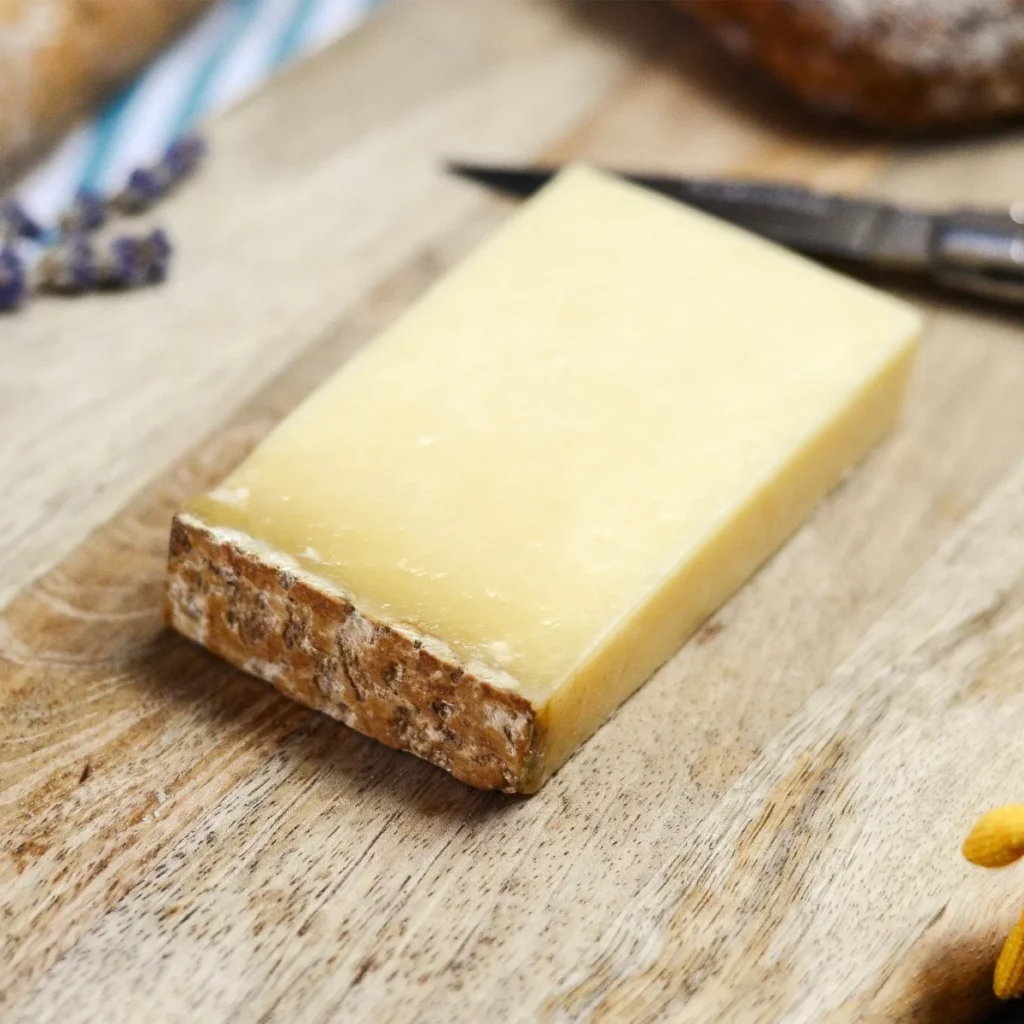
Frequently Asked Questions
1. Is Cantal cheese strong?
Cantal cheese has a slightly strong flavor, but it’s not as intense as blue cheese or other aged cheeses. The taste of Cantal cheese can be described as milky, with a hint of sweetness and a slightly tangy finish. It’s often compared to Cheddar due to its texture and flavor profile. However, the taste can vary depending on its age.
- Young Cantal: Also known as “Cantal Jeune,” this cheese is aged for at least 30 days. It has a creamy, buttery flavor with a mild tanginess.
- Aged Cantal: Also known as “Cantal Vieux,” this cheese is aged for at least six months. The aging process gives it a more robust flavor, with nutty and tangy notes.
While Cantal cheese does have a noticeable flavor, it’s not overwhelmingly strong and is enjoyed by many who appreciate a cheese that offers complexity without being overpowering.
2. Can you eat the rind of Cantal cheese?
Yes, the rind of Cantal cheese is edible. It’s natural and develops during the aging process. However, it has a different texture and flavor compared to the cheese itself. Some people prefer to remove it because it can be a bit tough and have a strong, earthy flavor. But others appreciate the contrast it provides to the creamy interior of the cheese. As with many cheeses, whether or not to eat the rind is largely a matter of personal preference. If you choose to eat it, ensure that the cheese has been properly stored and the rind is clean. Always remember to wash the exterior of the cheese before cutting into it to ensure any potential contaminants on the rind are removed.
Also read:
- What is Robiola? A Taste of Piedmont, Italy
- What is Parmigiano-Reggiano? Italy’s Cheese Crown Jewel
- What is Cooper Sharp Cheese? A Taste of Tradition
- What is Pepper Jack Cheese? The Spicy Star of American Dairy
- What is American Cheese? The Controversial Delight of the Dairy World
- Emmental: A Comprehensive Guide to Switzerland’s Cheese Haven
- What is Oaxaca Cheese? A Staple in Mexican Cuisine
